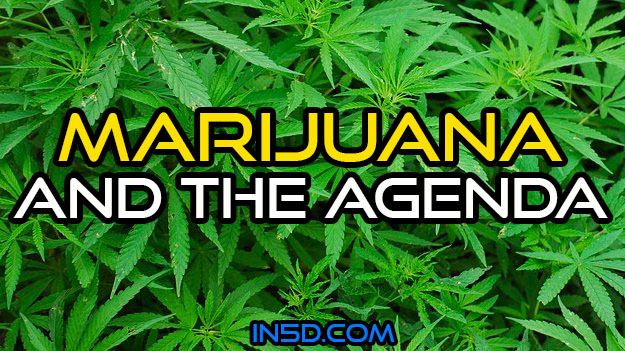Marijuana And The Agenda

by James Hallahan,
Contributing Writer, In5D.com
Marijuana And The Agenda
Without question, there is a strong relationship between psychoactive substances and spirituality. The foundations of spirituality, as we know, stem from shamanic practices which, at their core, are largely about reaching altered states of consciousness from which spiritual knowledge and understanding can be gained. Such methods are perhaps reasonable as this knowledge largely pertains to the underlying, metaphysical aspects of reality, which not only are imperceptible to the senses, but also conflict to a far degree with our ingrained perception of reality. By inducing altered states of consciousness, which is essentially retuning the receiver wavelength of our brain, it is possible to connect in some fashion with these aspects and to experience a shift in perception, which can indeed provide insight and aid in the exploration of consciousness and reality.
For the purposes of this paper, we’ll focus solely upon marijuana, from a neutral standpoint, with the aim to carefully evaluate its relationship to the authoritarian agenda and also its broader implications with society. I feel this is much needed as it is clear that marijuana—with perhaps strange suddenness—is now becoming widely accepted and is quickly making its way into mainstream society. This is no doubt, in many ways, a propitious advancement; however, it would only be sensible that we look at this from all angles and allow ourselves to conceive the various possibilities. In other words, we need to be observant and to just simply verify that all is as it seems with this movement. In particular, we need to give thought to the unanticipated “by-products”—and especially those that would seem to benefit the establishment.
What I mean here simply is that we cannot, and should not, rule out entirely (at least not yet) the possibility of an artifice. Certainly, without any doubt, this would seem to be inconsistent with what we’ve previously understood of the agenda. There’s no question at all that marijuana was rigorously kept out of the mainstream—and for very discernible reasons. This, I would suggest, was primarily due to the continuity of mind control and the preservation of conventional modes of thinking. However, regardless of its contrariety, we should perhaps not rush to judgement as to what’s truly been driving these present-day changes. We would hope that this is wholly reflective of the overall awakening—but, for the sake of caution, we should take consideration of some alternative possibilities. There are certain items of information that contradict the presumed understanding—indicating, potentially, that the prohibitive agenda regarding marijuana is different than we have supposed—or is changing.
Prior to getting into this though, we’ll first take stock of its benefits and overall usefulness. For our purposes here, I’m going to focus solely upon its spiritual uses. The medicinal benefits I feel are straightforward and need no explication.
What perhaps stands out the most is its exceptional ability to upset our ingrained social-programming and conditioning. As it turns out, this is a particularly suitable quality as the society we find ourselves in (as we will all have noticed) is an elaborate system of indoctrination. To those with open eyes, there is just very little doubt now that virtually all of the information we’ve taken in, since practically birth, is part of a long running and highly sophisticated deception. It need hardly be said that its employment was largely successful and has left the population in a state of almost total unawareness. Regrettably, this collective state is exceedingly difficult to correct as it is deeply ingrained into our psychology and of course is reaffirmed continuously, without rest, by virtually the entirety of mainstream information sources.
Somewhat remarkably, the effects of THC appear to alter perception in a way that nullifies these ingrained thought patterns and seems to precipitate what could be described as a kind of “outside the box” awareness. It is a markedly more contemplative state and thereby, with many, tends to result in a reinterpreting of traditional views. Oftentimes this does bring about a gradual change in perspective, which can to some extent facilitate the deprogramming process.
Central to this is the substance’s ability to induce what are perhaps, sometimes, rather perceptive insights. While under its effects, it seems as if the mind can more readily penetrate the surface of things and, through this, can reveal new dimensions of understanding which previously were imperceptible. It quickly brings to light that our normal state of awareness is actually very limited and (in its uncultivated state) tends to gloss over much that is significant. Very commonly these insights lead to realizations—and on the odd occasion, even complete revelations.
Another beneficial utility is its tendency to induce very deep states of reflection. In virtually an instant, it can bring to our awareness aspects of ourselves that we’ve been suppressing or unconscious of. It does this, I would suggest, through neutralizing the ego, which, once inactive, allows a much clearer observation of our internal self. This kind of ‘introspective analysis’ (or shadow work) is of course fundamental to spiritual advancement and is perhaps one of its more difficult challenges. The reason is that we are typically, in most cases, blind to our shortfalls—and, hence, without this awareness, we generally make no reparations. In this regard, we can perhaps say that marijuana is indeed instrumental—in that it can cast light on our unrealized aspects.
Continuing along, the next thing I would mention is its potent effect in countering our negative emotions. Provided that an adequate enough high is achieved, it can quell, in virtually no time at all, even the most tumultuous of upheavals. It would seem that there is (up to a point anyway) a kind of ‘consciousness raising’ effect and that it momentarily brings us to a wavelength where certain negative emotions, notably hate and anger, just cannot sustain themselves. While here, it’s as if there exists no logical motive for expressing negativity. The existence of hostility itself seems, for the moment, difficult to fathom.
The serviceability of this seems fairly beneficial. With spirituality, it’s relatively straightforward that a remedial effect on our emotional state would be supportive to the energy field. It could potentially foster healing and may to some extent mitigate the impacts of negative energy, and thereby prevent blockages. Furthermore, and in the same vein, it’s feasible that this may prospectively assist with vibrational attraction. If we’re now and then able to circumvent our occasional negative impulses—then, naturally, this would spare us the unwanted energetic repercussions.
Last but not least, I’ll briefly make mention of the alterations it causes with brain activity. As has been posited, the effect of THC is thought to suppress left hemisphere brain activity, and in so doing, further enables functioning of the right hemisphere. As a consequence of this, our creativity becomes enhanced and perhaps also, to some degree, our intuitive faculties. This, of course, is favorable to spirituality and may compare in some ways to the effects produced by meditation. Its practicality would perhaps be as a tool to assist in our investigation of reality. It may very well give us an edge to discern deeper meaning and an alternate means to glean potential truths.
And so now that I’ve appropriately venerated the sanctified herb, for the remainder of this paper I’m going to pursue a particular line of inquiry which, understandably, has been neglected. It likely would never occur to most of us that something could be amiss with the marijuana movement, but this is precisely why we need to look into it. If we fail to investigate and simply presume that all is fine and good—then clearly, we’re exploitable in this regard.
Moreover, their sanctioned procedure, as we have known for some time, is of course to relentlessly “co-opt”; to furtively take control over progressive movements and to then lead them into a direction that either furthers their own ends or is undamaging to the system. It is an understatement to say that they have been comprehensive with this and given that they are still very much at the helm of society, it can be virtually assumed that with most societal movements, if not all, they are no doubt on the inside, busily at work, doing what they do.
Therefore, as a matter of course, let’s momentarily put away our preconceived notions and, as a kind of exercise, conduct some analysis into alternative ideas—and from the angle that there is deception. We need to be thorough with this and so naturally with certain lines of thought we’ll need to give way slightly and contemplate what could potentially be negative. With this being said, we need to bear in mind that due to the conspicuous (or ostensible) prohibition agendum, and their obvious culpability, most of us are now primed in such a way that we only see this issue in black or white. We’re firmly convinced, though understandably, that if the agenda was oppositional towards weed, then its outgrowth into popular culture would exclusively mean good things for society. For the purposes of analysis, let’s just temporarily forgo this conclusion so that we can view this information with heightened impartiality.
Before I continue on, I’d like to make clear that regardless of what this information may indicate, its intent is in no way (not by any stretch) meant to caution against legalization. My personal view here is that we should wholeheartedly admit legalization, without any reservation, and if it suits us, campaign in its direction however much we feel necessary. It is vitally important that we have sovereignty over our own minds and, so long as we’re not a danger, that we’re unfettered and free to explore consciousness in whatever way we feel disposed to. The cautionary note, as I’ll get into, concerns primarily the general populace and, furthermore, the movement’s eventual culmination—which, in light of commercialization and other factors which I’ll present, may very well turn out unwholesome.
Now, getting to the incongruities as regards the agenda, the first thing we should bring into question, however baffling it may be, is whether or not marijuana was ever actually truly being suppressed. Yes, within mainstream society it does seem to have been restrained, but outside of it, within countercultures, it may have been quite another matter. To start with, it should be pointed out that marijuana is the most commonly used illicit drug in the world. There can be no doubt as to its incredible predominance and, likewise, it’s exceptional availability in practically every city, town and village everywhere. Against the backdrop of the control system—having in mind it’s extraordinary sophistication and the many feats involved in fashioning virtually every aspect of our culture—it just seems perhaps a bit peculiar that they’ve proven inadequate, to such a far degree, in extirpating this potentially factious culture of marijuana smoking.
With respect to this, attention should first be brought to the entertainment industry, which, we are all well aware by now, is essentially their primary device used to shape popular sentiment. We must note here, that their control over this business is no doubt extensive and in all likelihood is shared by no one—except perhaps other, equally dubious, elite factions. It therefore stands to reason, then, that literally the majority of movie productions, going back to the beginning, have not only been under their control and influence but are, in essence, a projection of the sought-after behavioral parameters required to advance their authoritarian agenda.
Being mindful of this, we must then of course come to terms with the uncomfortable implications. Mainly, that the sheer number of ‘stoner films’—films in which marijuana use is central and is portrayed as appealing—are just too high in number to seriously consider that they are unconnected with these broad programs of indoctrination. I’m not suggesting we presuppose, yet, that their sole aim is actually to bring about weed smoking—but, all the same, let’s duly acknowledge that this is without question a veritable by-product. These major films, (which I’m not downing) such as for instance the Cheech & Chong series, Half Baked and The Big Lebowski, we just cannot deny have, to a great extent, fostered the growth and attractiveness of marijuana use. And therefore, we must concede to the enormous improbability that this could have eventuated against the will of the establishment—who are decidedly in full control of this industry.
Alternatively, and perhaps conspicuously, there does not seem to be a very robust opposition pushing in the other direction. If it were the establishment’s wishes to quell the widespread use of marijuana, would we not then be seeing a different picture emerging from Hollywood? Perhaps, at the very least, there would be a relative shortage of these kinds of films. In any event, there should be discernible in movies a kind of countering sentiment, portraying a slightly divergent attitude towards marijuana. I’m certainly not implying “Reefer Madness” style; we’re much too conscious for that now. But it seems imaginable that there could be represented, inconspicuously, a kind of hard-headed way of thinking, made to seem intelligent, and that saw marijuana as, perhaps, unpragmatic or inexpedient. There may well have been such films in past decades, particularly during the Reagan era, but for the most part they’ve been few and far between, usually directed at marginal demographics, and are almost always feeble and unpersuasive. More to the point though, I think they have since vanished completely and that this is perhaps worthy of notice.
Also worthy of notice here, which surprisingly is escaping consideration, is the undisguised fact that billionaire financier George Soros—an undoubted antagonist to the free world and connected intimately with all things agenda—has this whole time been funneling literally millions of dollars into the legalization effort. Beginning in 1992, using Ethan Nadelmann as his frontman (founder of Drug Policy Alliance), the two have organized a massive, nationwide drug-reform initiative, and underlying it have erected a substantial network of pro-marijuana donors, which includes two other billionaires: John Sperling and Peter Lewis. Since then they have gone on to dispense more than 70 million toward marijuana policy reform and, needless to say, have yielded favorable results.
The reality of this situation, therefore, we cannot deny, is sufficiently damning—and, taken by itself even, should warrant the highest suspicion. There is just no doubt that this man is intrinsically involved and that wherever he’s offloading his millions, we can be sure that, underneath somewhere, something unscrupulous is going on. Furthermore, we can’t realistically ignore the fact that the political landscape of marijuana policy is largely a product of this massive campaign. And lastly, we’ll note that there was virtually no profit motive behind this endeavor; none of these billionaires own or have any stake in cannabis businesses. Nadelmann himself, has revealingly stated the following:
“I know from very deep personal experience that for-profit interests played essentially no role in marijuana legalization until 2016.”
The other red flag that we need reminding of concerns the inflow of marijuana into the U.S. and particularly the various players that are involved. At current, even though there are more domestic growers, the majority of marijuana in circulation is still largely coming from outside the country—primarily Mexico, via the unruly cartels. Not terribly by surprise, it has come to light, corroborated by many different testimonies, that certain agencies, chiefly the CIA, have all along been playing a central role, assisting the cartels, and using the proceeds to fund the iniquitous black budget programs. Yes, cocaine is referenced as the predominant commodity being trafficked, however, marijuana is of course part and parcel—and was (at least prior to state legalizations) generating more revenue than any other drug.
So, needless to say, the deductions to be drawn from this are quite revelational and would suggest that there may be a degree of variance between our perception of the agenda (relating to marijuana) and what has actually been playing out. Have they perhaps this whole time been playing both ends against the middle? Facilitating distribution on the one side, and then, on the other, enforcing prohibition? Bringing into existence a mayhem of legal troubles? Such a tactic, we must admit, does not seem entirely discordant with their basic goals—which, as we know, are to keep the population in a state of mental and emotional disarray. The major inconsistency, however, is of course the mind-opening qualities of marijuana, and how this would seem contradictory with their aims of keeping the population unconscious and narrow-minded.
In an effort to make sense of this, I’m going to put forth the serious suggestion that perhaps the majority of the spiritually-conducive qualities that I mentioned in the beginning, may not, in the final analysis, turn out as completely effectual in relation to the general population—or in other words may not yield a significant degree of spiritual benefit. This of course is suppositional, but if we just allow ourselves to ponder this question, I think that gradually it does start to make sense and maybe is, after all, fairly self-evident. If we just for a moment bring to mind the conventional culture of marijuana smoking and reflect on the manner in which it customarily unfolds—I think, if we’re being honest with ourselves, we just have to acknowledge that what’s taking place, for the most part, are not really so much purposeful experiences or deep moments of reflection, but rather just people seeking to amuse themselves—and, more often than not, in combination with electronic forms of entertainment. To reiterate, I am not saying that the herb doesn’t impart enlightening benefits, but simply that most average people, for reasons which we’ll explore, are either not receiving them at all, or to a small enough degree that it’s inconsequential to the establishment.
To reaffirm this premise, all that really has to be done is a simple mental exercise, recalling to mind all of the people we know that smoke marijuana. As long as you live in the real world, you just can’t help but concede here that the great majority of them, for all intents and purposes, are still sound asleep and acting within parameters of the control system. This certainly is not in any way meant to undervalue them, but merely to point out this fact and to convey the idea that, due to certain factors, weed may be less problematic for the system than we think. After all, we should remember that it has been here practically all along, widely available and in huge quantities.
Following up with impartiality though, I will grant that with all of these same people (who retain total conformity despite weed) there are most assuredly, in many respects, positive changes in outlook that do take place. Indeed, many of them become more thoughtful and now and then will take up alternative viewpoints, particularly with health and medicine. Additionally, at least from my own observations, there always does seem to occur a kind of softening of the defenses, whereby the user, almost from then on, tends to behave more peaceably. And to be sure, there exists with a fair number of users as well—but generally only up to a point—a propensity to neglect social norms.
Returning to the previous supposition regarding the limitedness of its enlightening effect, the question then is what are the underlying reasons? Why is weed not as spiritually serviceable with some as it is with others? I think there are multiple answers to this, and the most ostensible being that it’s dependent largely upon our individual predispositions. Or in other words, the differences in our inner psychology are what is responsible for its variation in effect. Along these same lines, we could perhaps speculate that spiritual maturity is a probable factor as well. It may well be that the broad majority of humans on the planet are relatively young in a spiritual sense and may therefore be less apt, in general, in connecting with their spiritual selves.
What may be influential as well in this regard is the overall culture surrounding marijuana. I think it can be said that this culture and background that it has been steeped in, predisposes us to some degree in terms of how we react to it and the experiences that we have. Moreover, I think it can be suggested that the formation of this culture was not altogether natural and that perhaps it is actually central to their overall strategy in mitigating marijuana’s beneficial effects.
Perhaps the best way to exemplify this is to simply imagine a society that possessed a different attitude towards marijuana. A society that regarded its purpose as not of recreation—or even really relaxation—but rather as a method and approach to investigating reality. As simply a means to alter perception with the sole aim of gaining insight and knowledge. I think, with such a culture, it’s safe to say that their members would in all likelihood take to weed in a very different way—and may potentially have entirely different experiences as well. It may prove to be the case, with this kind of society, that marijuana is indeed an effective catalyst for spiritual development.
Now, in contrast, bringing to mind our own society—where smoking weed amounts merely to frivolity and laughter—it really isn’t hard to fathom why spirituality rarely precipitates. And against the background of all-encompassing manipulation, we can reasonably infer that this frivolous culture is by no means a coincidence. They of course recognize, completely, that we mimic to a fine degree everything that we witness on our screens and, more so, that we’re afraid to deviate from it. And so, as we might expect, just as they have been shaping all other areas of perception, they likely have been doing the same with marijuana, via the entertainment industry—and thereby have lessened its potential to positively affect society.
And so, getting back to the exploratory premise of how they could actually be (advertently or inadvertently) furthering the use of marijuana, we can perhaps now begin to, at the very least, conceive its possibility. The positive references to marijuana, strewn throughout modern entertainment, are really not a problem for them because the population has been primed in such a way that the spiritual upsides are to a significant degree neutralized. The question now is what exactly is their agenda with regard to all these references—or more precisely, their acquiescence to them.
With this aim, we’ll go down multiple lines of reasoning, so as to be thorough and explore a broader range of possibility.
To begin, we’ll make the presumption, as most understandably would, that the advent of widespread marijuana use (the 1960s) had arisen completely contrary to the establishment’s intentions. If this was indeed the case and marijuana use spiked naturally, we could then maybe conjecture that its representation throughout music and film history was perhaps a kind of countermeasure, intended to gain control over perception, so as to mitigate its subversive potential. Possibly consistent with this angle is the fact that positive weed references in movies did not begin until the late 1960s, (after the onset of weed) when the Motion Picture Production Code changed to the MPAA rating system, which removed restrictions on portraying drug use.
The problem with this angle, on the other hand, is the music side of the industry. The marijuana references stemming from here begin reasonably earlier than the motion picture industry. Roughly speaking, they begin (candidly) around 1964-65. Indeed, from this we can deduce that it was not the music scene (surprisingly) that triggered the outbreak of marijuana—but, at the same time, it would be hard not to draw the conclusion that music was predominantly what fueled its enormous outgrowth. Thus, we need to make note of this as a potential inconsistency. And furthermore, I think we’re obliged to face up to the fact that the rise of marijuana was in large part enabled by a controlled industry, recognized clearly to be the elite’s principal means of social engineering.
Now, in terms of what actually caused the increase in usage, the answer is peculiarly difficult to pinpoint. Many feel that it had to do with a newly-emerged leniency towards the substance. Sufficient grounds suggest this was in part due to reports commissioned by the Kennedy and Johnson administrations, which found that use of the substance did not induce violence nor lead to use of heavier drugs. Indeed, Kennedy may genuinely have been at variance with the agenda, but we’ll note still that this impulse is stemming directly from the government, and further, the questionability that Kennedy (assuming it was calculated) was at all cognizant of what would clearly be an inconspicuous aspect of the agenda.
Apart from this, consideration should also be given to the underground proceedings of drug trafficking networks. Though it is difficult to substantiate, we should not rule out entirely that there could have been an unappreciated impetus. Perhaps it’s feasible that there was a timely augmentation with the amount in circulation. In view of what’s been alleged, regarding the cooperation of U.S. government agencies with Mexican cartels, it is not unreasoned to suppose that they’ve all along had a firm grip on distribution. If such is the case, then we clearly have further to wonder about the emergence of marijuana during the 60s.
On the other side of things, we do need to take into account another factor regarding its inception. It seems clear that there was indeed a kind of large-scale spiritual awakening going on at this time. The sudden cultural transformation that occurred may not have been merely a reflection of the psychoactive experimentation, but rather something more fundamental. From this perspective, the increase in usage of marijuana could perhaps be interpreted alternatively as a by-product of these awakening minds, who, perhaps naturally, would have habituated themselves with such substances.
We’ll continue on with procedure though and turn over every stone; there are other inconsistencies which conflict with our original premise and further suggest a different story. In this regard, I would direct attention to the conspicuously futile exertion known as “prohibition”. I think we must confess here that this is just a bit below the mark by which we’ve come to know them. Is this truly their chosen strategy to prevent use of the substance? Are they not aware that prohibitive actions tend to produce the opposite intended effect? I think it’s highly unlikely that they don’t know this—and therefore, we should probably consider this to be a potential red flag, suggesting that they may indeed have been desiring the inverse and present outcome.
In this same vein, we should recall as well that the state prescribed drug prevention techniques—namely the act of ramming down kids’ throats fear-based slogans about the danger—are equally counterproductive and, by almost all kids, are interpreted as “lame” and something desired to be on the opposite side of. Could the establishment really have made such an obvious mistake? Did they actually think that this would deter kids from smoking marijuana? I think maybe there’s enough grounds to make the suggestion that perhaps they didn’t—and that they fully understood the result. Furthermore, I think it was this pointedly “lame” manner of prevention that particularly goaded the counterculture of the 1960s. The scare tactics used then, it should be noted, were distinguishably exaggerated—and, as a result, virtually no one was fooled, but rather were enticed. And again, this seems incredulously flawed.
And so, as I think has been indicated, there are marked inconsistencies with our initial premise, which suggests that this may not boil down to a simple reactionary measure in response to marijuana use. There may in fact be, at the heart of this, a much deeper strategy, so far largely unexposed, and which contradicts the prevailing conception. The bottom line here is that with all of these factors that fostered the growth of marijuana, controls have been in place which feasibly could have obviated the enabling circumstances. Curiously though, it seems they did little to employ them—and in reality, appear to have done the reverse.
Considering this, I think it’s now become necessary for us to bite the bullet and entertain some unpopular ideas. We simply have to explore this, for in not doing so, we’re leaving open a blind spot which certainly would be better closed. After all, this is an investigation. We have possible inconsistencies and so naturally we need to follow through and consider the various possibilities. To do otherwise or to dismiss them is surely not in the interest of truth, nor in line with reason. Moreover, it does not by any means place us in opposition to marijuana, but simply in a position to further our understanding of the agenda.
So, with that said, we’ll now explore a new premise—and one which perhaps throws light on the mystery of this seemingly illogical handling of marijuana. To start off, I’m going to first reassert the idea—which I think has been well demonstrated—that the forces behind the curtain are reasonably sophisticated. I think it’s safe to say that what we’ve uncovered of their handiwork presupposes an enormously intricate methodology, which seems notably to include remarkably distant, and detailed, long-range planning. How this is achieved, save for recent undisclosed technologies, is through routine interdimensional correspondence, which essentially gives them a prognostic capacity and, of course, direction on how to apply it.
With the aid of this foresight and direction, it seems legitimately to be the case that all along they have been engineering society to very precise specifications, down to perhaps even minor details. It can be conjectured from this that most major societal determinants (or at least a fair amount of them) have plausibly been introduced by them, and are in some way integral with the overall agenda. By the same token, we can conjecture as well, that any major determinant not introduced by them, they of course have long anticipated and have taken full account of. Consideration should be given to this comprehensiveness.
Now in addition to this, we need to of course bear in mind their time-honored modus operandi. It’s no doubt been recognized that their standard approach is not just merely to corrupt societal institutions and movements, but to literally invert them—whilst leaving everything aboveboard seemingly still fine and containing virtue. Unfortunately, it does seem to be the case that they’re being systematic with this goal and that it may in fact constitute as a kind of religious compulsion with them, and which they’re deeply devoted to. And consequently, we seriously now have to wonder about the true state of nearly every aspect of society. Is it as it seems? Or is it perhaps the other way around?
Now as far as marijuana is concerned, there certainly is no reason to presume that this question would not be applicable. After all, this is an expansive counterculture and, more than that, it is perceived conventionally (or was) as a symbol of rebellion against the establishment. In view of this, we should agree that it’s very probable this would have been high on the list for inversion. Would they really have omitted it and looked the other way? In all likelihood they probably haven’t.
Therefore, we should set forth this premise with the presumption that marijuana has indeed been inverted. The traditional practice of marijuana, we’ll theorize, has been surreptitiously corrupted and, thusly, for it to be inverted, there must be something potentially adverse or some kind of outcome stemming from it that plays into the hands of the establishment. Of course, this is a highly disagreeable notion to the stoner, as well as many spiritual types—but, regardless, we need to be free-thinking and unrestrained by the common predilection.
So, in beginning this deduction, I would first draw attention to the marijuana timeline, specifically its stage by stage advancement into society. We can surmise from this that whatever pernicious effect they intended to derive from marijuana, it clearly was either not needed or was not prudent to introduce at the earlier stages. I suspect the general idea here must relate in some way to the upsides of marijuana, particularly its subversive effect on the conditioned mind. There may be a timetable that they’ve worked out and have deemed it important that it be restrained up until a specified point. So this would additionally suggest that marijuana was in fact harmful to their designs, but that perhaps new conditions, or likewise the evolving nature of the agenda, have possibly changed this fact or have at least diminished its potential.
So, prior to the 1960s, the conventional (programmed) modes of thinking dominated society, and they wished to maintain this perhaps and evidently felt that marijuana was too incendiary and smartly kept it under control. However, post 1960, as was covered, we clearly have an enormous discrepancy with the establishment-condoned music culture—which undisputedly encouraged, massively, the widespread usage during the 60s. They just cannot be seen, believably, at this point to be suppressing the marijuana counterculture. And thus we have an indication that the agenda/conditions have changed—and that now, for some reason, marijuana is not only admissible to them, but is something they in fact seem to be ushering in.
As to the reasoning for this change, I would first point to its correlation with the 1960s awakening that we touched on earlier. If indeed they were ushering in marijuana, and it wasn’t just simply a by-product of the awakening souls, then surely this timing must mean something. Perhaps, now, just as an exercise, we should look at this situation conversely—and seriously consider if there isn’t possibly some obscure fashion in which weed could have been utilized counteractively.
I think, first, we should pose the question of what would have occurred with the awakening had psychoactive substances been out of the picture. Were they really in fact necessary for it to have taken place? Perhaps, in spite of everything, they really weren’t necessary. Perhaps it would have happened one way or the other. We do know for instance that spiritual awakenings are innate manifestations, stemming of course from the soul-level. Yes, external circumstances do at times facilitate them, but most likely, I would suggest, are not dependent on them, and could surely still arise despite them. So if we just momentarily postulate a weedless awakening (premising that it would still take place) the first thing that may spring to mind is that there is now an incredible mystery here. We have a conspicuous phenomenon which puzzlingly is not localized but, on the contrary, is hugely widespread. It is a mystery that, minus psychoactive drugs, is now not so easily explained.
Donate to In5D
With over 6,000+ free articles and 1,200+ free videos, any donation would be greatly appreciated!
Much love for your kind donation,
Gregg
So, in essence, we have an “ostensible reason”— which I’m suggesting not only obscures the anomaly of the awakening, but perhaps does much more than that. If we can just for a moment ponder on the awakening souls at that time: We can probably presume that, by and large, they were mostly gravitated towards the counterculture and, more precisely, were getting stoned—and perhaps experimenting with psychedelics. If we then bring to mind the various functions which we could speculate are required of such individuals—namely bringing to public awareness the fantastic truths of reality—we can see then that there’s a bit of a hitch now along the way. The problem is that with the spread of marijuana and psychedelics, there has also been, simultaneously, the emergence of a common sentiment relating to the credibility of experience. From the inception of drugs and onward, the information/testimonies of especially those associated—pertaining to anything outside the norm—unfortunately, we have to admit, are now easily relegated as being the product of mind-altering substances. It is exemplified nicely with the classic, incredulous line: “Well that explains everything.”
Now, indeed, this is just simply speculation to account for our premise—but I tend to think that this may be quite plausible. If we perhaps view this from the perspective of the establishment, it may provide some insight here. We know, for instance, as mentioned, that they have prognostic capabilities and that, therefore, the 60s awakening was known to be coming and certainly was looming large on their horizon. There can be no doubt then that they were well-prepared and likely had in order a major counterplot to be implemented simultaneously. If we surmise this to be the case, then what arrangements did this counterplot comprise of? Moreover, what precisely were the goals they were hoping to achieve by it?
Above all, I would say that they absolutely did not want the awakening souls to be of much influence to society. And so, if we just imagine setting our minds to this goal, what feasibly could be contrived as a means to marginalize such a huge segment of the population? I think if we strained ourselves in mental effort over this, we may ultimately decide that the best option is to draw them in their entirety into a premeditated counterculture, which is saturated to the brim with mind-altering drug use—and which, by virtue, is regarded by the outside as questionable and highly discrediting.
We have to ask ourselves: Would this not be a rather effective strategy? We have a movement of people who threaten to inspirit the population and potentially bring to light the veiled aspects of reality, what better way to obstruct this aim than to thoroughly segregate them from the rest of society. And from there, to co-opt and shape the movement so that it is not only objectionable (to the mainstream), but so that all “extraordinary” information stemming from its individuals is suspected and disqualified, owing to the nature and effect of psychoactive compounds.
Of course, it may only have been natural that the awakening souls would have set in motion an objectionable counterculture, but I would suggest though that its particular manner of objectionability, its brazen effrontery, may actually have been calculated and was perhaps part and parcel of their counter-strategy. If we, for instance, take drugs out of the picture, how objectionable is it then? In this connection, could it be possible that the excessive vilification of marijuana was also, in part, carried out for this reason? Could it be possible that their goal was to prime the mainstream so that it would staunchly reject the values of the known-to-be-coming counterculture? Was marijuana designed to be temporarily anathema? So that the ideals of peace and love would fall on deaf ears?
Whatever the case may be, it seems clear that the 60s awakening was by no means successfully impeded. There’s no question that its energy overwhelmingly spilled over into the mainstream. To put it simply—it resonated. Its light radiated through, and the collective level of consciousness, there’s no doubt, underwent a shift in the desired direction.
The point here, to reiterate, was to explore the possibility of an alternate (inverse) agenda relating to marijuana, so as to account for the aforementioned inconsistencies. I think, in light of what we’ve covered, we have to acknowledge that this is entirely conceivable. If the awakening was going to occur nonetheless, and if the positive sides of marijuana were more or less nullified, then it would seem to be the case that this is in fact manageable—and that it could have indeed been applied to ill-effect.
The question now is the ongoing situation succeeding the 1960s. The fact of the matter is that they did not genuinely, in any way, reverse their course from this. Marijuana continued to flow into the country via the CIA-backed cartels; the music groups continued unrestainedly with their praise; drug prevention techniques remained lame; prohibition largely ensued; and Hollywood, joining in, introduced to us the weed-appreciative Cheech & Chong. Indeed, political sentiment throughout the 70s and 80s did seem to waver between criminalization and decriminalization, but let’s remember that this is “on the surface”, and that this purported level of authority is not entirely authentic.
So what can be gleaned from this is that the agenda is of perhaps a broader scale and more far-ranging than what we’ve so far covered. We can presume as well, due to the gradual ingratiation of the substance, that an evolution of its future application must have all along been in the cards. That is to say, the speculations I’ve made about its adverse utilities during the 60s, particularly its stigmatizing effect, would no longer retain validity as it becomes increasingly more accepted—and so, concerning the later phases of the agenda, they must have had in mind an altogether different reason for its allowed distribution.
Earlier in the paper we touched on the notion of legal troubles resulting from marijuana. Due to its criminalization in most parts of the world, combined with its heavy trafficking and prevalence of use, there’s no doubt that this has created enormous turbulence in society. In just America alone, there are on average roughly 650,000 marijuana arrests per year. Literally half of all drug arrests total are from marijuana-related offenses. These are substantial numbers, and it can be easily appreciated how this is resulting in a significant disruption of peace and harmony, causing things like job losses, burdensome fines, incarceration, breakup of families, etc. And so, going down the list of possibilities, we do need to take this into account as one possible overall reason—for we do know that societal instability is something they place importance on.
However, as can clearly be seen in America, the tide of policy in the last two decades has been shifting in the unexpected direction. A broad liberalization of marijuana is unfolding as states are now reducing penalties, admitting medical use, and even, with some states, completely legalizing the substance. Needless to say, this is enormously heartwarming as it seems to mark the beginning of the end of the War on Drugs, which undoubtedly is an absurd injustice that ruins the lives of millions, whilst having virtually no effect on the problem. We can of course credit the heightened energies/awareness as playing a major role with this, but naturally, to appropriately appraise this, we should be more thorough and consider other possible factors—and especially in light of what we’ve covered.
As discussed earlier, we have the robust campaign initiated by Soros, which certainly much of this can be attributed to—but, in addition to this, we should perhaps review again the activities of the entertainment industry and also the media—for public opinion, even now unfortunately, is still largely a product of the information we’re provided via these sources. And so, looking at the entertainment industry, it can be seen (through researching this) that the progression of marijuana references (after the 60s) is a slow and steady ascent until about the 1990s. At this time, somewhat abruptly, there is a dramatic increase in references—and all across the board. Small references here and there begin turning up in television shows (The Simpsons, Roseanne, Friends, etc.), with Hollywood there was a significant increase, including the highly popular stoner films: Dazed and Confused, Friday, Half-Baked & The Big Lebowski—and in music, particularly with hip hop, there was an enormous transformation with lyrics, which became largely focused around substance use—primarily marijuana.
In perfect correlation with this, we find a substantial and widespread increase in usage, which is not only in numbers of people using, but also with intensity of use. It was a dramatic enough increase that it was recognized all throughout America, and indeed most everyone at the time regarded this as being self-evidently due to the entertainment industry—particularly the hip hop artists. And this does appear to be accurate that it was emulation as there are certain details, like for instance the widespread emergence of blunts, which were relatively uncommon until they became featured repeatedly in hip hop—at which only then did they become prevalent. Furthermore, we have the advocates themselves who regard this period of increased marijuana representation as being fundamental to its normalization and present-day acceptance.
By virtue of these facts, we might now ask the question of just what in the hell is happening backstage during the midst of all this? Have they been nodding off at the controls? These are their own deeply penetrated industries. These are their own (alas) mind-controlled artists who are leading the charge. Should we not now, at this point, start to wonder if there’s maybe something amiss here. We do know, for instance, that these artists, by and large anyway, are not exactly “naturally-occurring”, and that there is selection and grooming that takes place. We know as well that in the event of their nonconformance, there is always a punctual rescindment that occurs; their skeletons are drug out of the closet and, without delay, they’re swiftly defamed. How then, for instance, does someone like Snoop Dogg continue to thrive on and on whilst being one of the biggest and most influential proponents of marijuana? Perhaps this doesn’t add together.
Moving down the road some to the 2000s, we’ll take note that marijuana representation has not only increased, but has increased considerably. The Wikipedia “List of films containing frequent marijuana use” (which is not a complete list) indicates a significant jump from 21 films in the 1990s to 53 films in the 2000s. This is roughly a 150 percent increase and when we factor in that during the 80s the number was only around 11, and in the 70s about 7, we can see that these numbers aren’t exactly sporadic, but that there’s a progression here.
Fast forward now to the 2010s, and the most significant development we have here is the release of CNN’s now four-part series “Weed”, by Sanjay Gupta. Beyond any shadow of a doubt this was monumental and contributed substantially to its current acceptance within the mainstream. It was a major news network essentially condoning medical marijuana, and for the first time. Now, in all seriousness, how on Earth do we account for this? There can be no question that this network is entirely in their fold and is meticulously controlled from top to bottom. The idea that something major could surface on here that is in disaccord with the agenda is very close to inconceivable.
What some may hypothesize is that there has maybe been a takeover and that these are perhaps indications of “white-hat” renegades working on the inside, trying to set things straight. We of course can’t dismiss such possibilities entirely, as this may be to some small extent happening—but with these particular areas (entertainment & media), we can see that overwhelmingly this is not the case. With entertainment, it is plain as day that all across the board there is transpiring a major incursion of conspicuously low-grade sentiment, going to almost astonishing extremes, and which reeks strongly of the agenda. Unfortunately, it is unmistakable that the broad majority of stoner films are bearing this same tell-tale sentiment and, above that, are often made by the same people of much darker films. With the media now, certainly CNN, we have exactly the same story. Outside of these marijuana documentaries, we have virtually no indications whatsoever that anything has changed. It is clearly business as usual, and apart from this, the simple fact that the weed documentary has been ongoing suggests further that this is not any kind of oversight, but rather something that is almost certainly intended.
So, getting back to its present-day acceptance and progressing legalization, I think we now have some questions—and ones which are in definite need of answers. Simply put: Have media and entertainment been predominantly the driving force behind public approval? Would not the landscape be entirely different were it not for its positive representation in film and television? Certainly, as we’ve covered, the awakening has engendered increased open-mindedness which naturally would facilitate this to an extent, but we still can’t negate this additional and perhaps critical propulsion via the establishment apparatuses. We therefore need to embrace the possibility that they may have all along been behind this—and right from the very beginning.
Before we speculate on the functionality of such a design though, we’ll take a look at the obvious conundrum that clearly this would implicate. The simple truth here, which I think is beyond dispute, is that marijuana is a remarkably effective antidote for aggression and violence. If its use were to expand significantly and become commonplace like alcohol, it would be difficult to imagine how this would not lead eventually to a major reduction of conflict and unease. I think this may be the one by-product of marijuana that cannot be realistically avoided; when people get high, they almost unpreventably become more chill. And so we have to wonder about the contrariety of this situation, particularly in relation to their aims of chaos and disorder. If they’re advancing marijuana, chaos and disorder are likely going to subside and people at large may very well become more relaxed and easygoing. It seems contradictory with the agenda, but let’s just pause and contemplate this for a moment. Perhaps it isn’t.
What I mean here is that it’s very possible, perhaps even probable, that throughout the course of the agenda there would end up being considerable alterations with strategy. There may arise certain times when societal conditions need to be modified significantly so as to pave the way for new and different phases of the agenda—so that perhaps certain objectives can be easier facilitated. If we take a step back and consider this, we may find there’s a certain amount of coherence now.
In explanation of this, let’s first briefly recall to mind the ambitions of the agenda and its current point of development. Essentially, we have the gradual encroachment of authoritarian control, with its ultimate aim being a centralized global dictatorship. As can be seen, they’re relatively far along with this: We have the ever-expanding amalgamation of economies and nation states; we have the blatant subversion of free speech; we have the massive escalation of surveillance and violation of privacy; we have the extortionate militarization of police forces; and now, as we can see in Sweden, they’re moving right along to the insidious microchipping agenda.
So, I think it’s fairly straightforward that what’s happening here is that they’re in the final act of dropping the cage down. I think therefore they understand that it’s only a matter of time before the bars start to become visible, and due to this, they’re probably anticipating and planning for a certain amount of unrest. And we know, because of the incremental progression of things, that they do not desire an antipathetic populace, which therefore makes it probable that they have a strategy at hand intended to mitigate the backlash. In other words, their guiding principle may, at some point in the future, switch from chaos to that of docility.
If we take the time and examine the recent unfoldings of society and consider what this mitigating strategy might be materializing as, we might come to recognize eventually that marijuana fits this bill precisely. In support of this, I’m going to put forward, for what it’s worth, a little known fact, which I think may substantiate this: The simple fact, which is affirmed by many unbiased historians, is that marijuana, for centuries, by European and Arab slave traders, was used to great effect as a method of control and subjugation. University of Kansas professor Barney Warf, in an interview with Vice, comments on this while discussing its origins in America:
“It [was] brought to the Americas by the Portuguese, who took it to Brazil, and again by the British, who took it to Jamaica. In both cases, it was used to pacify slaves.”
This may be somewhat of a surprise, but for all of us who have had even the slightest experience with weed, we clearly must nod our heads in agreement as to the feasibility of such a tactic. There is just no denying that in such situations where intensity of emotion or discontent threatens to precipitate revolt, that marijuana would easily do the trick and effectively calm tensions. It may not change minds of course, but conceivably it would lessen to some extent the impetus that may give rise to insurrection.
So, in light of this fact, I think it may only be reasonable to harbor a few suspicions about this movement. We’re potentially at a critical juncture where activism from the general public may be necessary and even vital to prevent further advances of the agenda. We’ve already identified that a number of other chemicals, namely psychiatric meds, are being employed largely for this same reason of making people more docile. We should seriously consider that marijuana, notwithstanding all its benefits, might technically be a more potent agent in this regard. Not only could it certainly pacify, but it has also the unfortunate by-product of inducing significant languor, which naturally of course stymies initiative and drive. For all of us who have experience with the plant, we just cannot claim with sincerity that this is unfounded. The stereotype of stoners being passive and leisurely, we can clearly see, has more than a grain of truth to it.
Again though, it’s important to make clear that ordinarily this would not present any problems and may only contribute towards peace and contentment. However, with an impending totalitarian takeover near at hand, bearing in mind the narrow window, this may turn out to be an unideal point in time for everyone to be getting stoned. A passive and leisurely populace might realistically serve to great advantage for those who wish to entrap. Of course it would benefit many and facilitate spiritual progress with some—but overall it may end up precipitating a great deal of complacency, and at a time when what we need is concern. The common notion that marijuana would only serve to awaken minds to the agenda, (which of course has its merit) may not ultimately retain its relevance given that, in due course of time, the reality of authoritarianism will likely become transparent and no longer concealed.
And just so there is no misinterpretation, this is not at all suggesting that we require an angry backlash against the establishment. Certainly, this would not be favorable and would only serve their own purposes and further “justify” authoritarian methods. However, when it comes down to it, we may truly end up needing from the populace some kind of emotional response—for otherwise what would drive people to such profound changes? Ideally, in a world of spiritually disciplined minds, where people are diligent and governed solely by conscience, we could perhaps maintain tranquility and simple awareness of the problem would be enough to motivate us in the direction of change. Realistically, however, in a world where everyone, due to financial and social constraints, is securely locked into the status quo with no room to maneuver, it is hard to imagine a movement that could sustain itself without some kind of major impetus—which, let’s be frank, could really only come in the form of a fervid discontent with the present situation.
Moving on, what else needs to be considered here is the eventual culmination of the movement and of marijuana itself, which feasibly may turn out as something very dissimilar from our initial expectations. Broadly speaking, the problem is that it’s slowly but surely deviating from the natural to the unnatural and from the sensible to the unsensible. As far as unnatural goes, we should maybe consider open-mindedly the continuous enhancement of THC content, which may not have been entirely designful, but nonetheless has changed the herb into something that perhaps wasn’t wholly intended by nature—and which perhaps is not in all respects benign.
Indeed, it would seem beneficial and that it may only be increasing effectiveness and efficiency of use, but in actuality there’s a slight problem here. The vast majority of these modern strains have grossly incommensurate ratios of CBD to THC. In fact, despite the recent interest in the compound, CBD concentration in marijuana has declined significantly (owing to the focus on THC), and many strains nowadays contain virtually no CBD at all. This is surprising, but as it stands now, most users of the substance may not actually be receiving the health benefits (in their full degree) and are smoking strains which could be considered mildly unfavorable in effect.
The reason for this is that CBD is not just simply a supplemental compound, but rather an integral one. It is a necessary component, possessing antipsychotic properties, and which needs to be present in sufficient amounts, so that it may counterbalance the THC. When the amount is insufficient, (at least with many types of people) the herb has a much greater tendency to induce negative psychological states, such as anxiety and paranoia. And it’s worth noting here that these kinds of experiences with marijuana seem to be on the rise. More and more people are having adverse reactions to it, and even experienced users themselves, after a number of years smoking these strains, will end up giving up the habit when finding that it no longer relaxes them, but actually makes them anxious. Of course, there is probably a range of different factors which play into this, but from what we’re learning about marijuana and the role of CBD, it’s possible this may be an overlooked determinant.
While we’re on this subject of immoderate THC consumption, we naturally need to address the problem of suggestibility. As has been established by many experiments and peer-reviewed studies, (which obviously are obscure and unlikely to be connected with any scheme) marijuana, along with most psychedelics, have the unfortunate tendency of increasing suggestibility. Roughly speaking, this occurs simply due to the suppression of the analytical mind, which of course in many situations is favorable (spiritual practice, etc.); however, in many other situations, it clearly presents some issues—i.e. when being subjected to sophisticated mind control via the television screen.
What’s going on here with television mind control, in part anyway, is something called “brainwave entrainment”. Most people aren’t aware, but the refresh rate (or flicker rate) of TV screens are deliberately configured to certain frequencies which induce lower brainwave states. This is intended as these states of mind (aside from their benefits) render our subconscious more receptive to outside suggestions—namely the subliminal ones, which are suffused all throughout film and television. The addition of a mild psychedelic, such as marijuana, we might want to consider could be a significant enhancement to this apparatus. After all, this is precisely why drugs have been used in conjunction with mind control; by increasing suggestibility, they enhance considerably its induction.
The stipulation though, I would suggest, is that its efficacy is ultimately conditional: It depends on how exactly we’re using the herb. If our goal is consistently to achieve maximum intoxication with the usual aim of electronic amusement, and we’re, in each instance, essentially plugged into an LCD screen—with no inclination to question its content—then, safe to say, mind control is going to have its way with us, and marijuana, despite everything, will not be serving to our advantage, but merely to our entrainment.
I’m going to assert here that dosage is relevant and has a direct bearing on the potential of this. This is not to say that high doses shouldn’t be experimented with, but simply that intensity of use, which is essentially customary now, increases substantially the viability of this design. My own observations here, we can perhaps relate to: Throughout the majority of my experience with marijuana, I used it relatively conservatively and refrained from smoking large amounts, simply because the impact on my energy level was just too much of a cost and therefore didn’t seem sensible. However, on special occasions, when with friends, I would of course now and then deviate from this and smoke a little over my limit, and sometimes to considerable excess.
On such occasions, I would notice that my experience watching movies was appreciably different than when just moderately high. Even though my normal tendency (being at variance with orthodoxy) was to view movies with a degree of detachment and critique, I would curiously in these instances find myself surrendering to the sentiment of the film. I would become absorbed and brought to its wavelength essentially, viewing it more or less as intended by its makers. Of course, in themselves, such alterations of perception are not a bad thing and, indeed, have much to offer us in the way of learning and spiritual enlightenment. However, in front of the TV screen, with state-of-the-art mind control at the other end, and with the analytical mind completely and totally out of the picture, the baked state of consciousness unfortunately, with most average people, amounts to increased receptivity and ultimately a vulnerability.
Therefore, we need to acknowledge that an altered state of consciousness can in some ways act as a double-edged sword, and furthermore that the potency of modern marijuana is what amplifies this particular danger: if we’re smoking stronger and stronger weed, then we’re (generally speaking) getting higher and higher, and thus more and more susceptible to the effect of television mind control. Yes, awake and aware individuals proficient in discernment and alert to noxious sentiment may potentially fare better and come through less afflicted; however, as with most of these concerns, it’s the general public and majority that we’re worried about. We cannot reasonably expect, due simply to being high, that they will intuitively surmise its malignancy and then break away from it. We need to realize that the opposite is true. They’re not suspecting anything whatsoever—they’re entranced. They’re liking the characters, and accordingly they’re molding themselves in the exact same fashion.
Getting back to the movement, the next thing we really need to consider is the inevitable craziness of commercialization. The situation here as it turns out, due to impossible regulations, is that the cannabis industry is dominated, and will continue to be dominated, almost exclusively by big business. So let’s just acknowledge then that the ultimate form and direction of legal marijuana is largely in the hands of profit-seeking materialists—who, as a general rule, are not overly concerned with altruism and what’s right and wrong for society. In all likelihood, they’ll operate in much the same fashion as Big Tobacco: they’ll aim to create and maintain heavy users, which is where the bulk of their profit will come from. As part of this, we can certainly expect down the road some questionable marketing practices, which no doubt will pose the risk of alluring teenagers—which is not a good thing. The science which suggests that THC may be detrimental to a developing brain may potentially have legitimacy.
Furthermore, taking note of what was done to tobacco (in terms of increasing addictiveness and profitability), we should not rule out that something similar might take place with marijuana. Genetic manipulation I would think is probably imminent, and weed fans, surely, when it’s revealed to them it’s enhanced cannabinoid concentration, will probably forge ahead and throw caution to the wind. In addition, there’s certainly the probability of additives, which is already occurring with a lot of growers. Many types of chemicals are being added for various reasons, which isn’t limited merely to pesticides, but includes also a variety of extraction agents, such as butane and even hexane, which are not exactly salubrious.
Finally, mention should be made of the edibles craze, which already, in states where it is legal, has completely transformed the face of marijuana to an extent where it is no longer actually marijuana, but rather just extremely high and unnatural concentrations of THC housed inside materialistic indulgences. It seems maybe benign, but in a certain respect, when all is said and done, this may end up degenerating the practice to an even further degree—and to a point where all semblance of purpose is long lost and only frivolousness remains. Further than that, we should take note as well that edibles are very much an attraction and may serve to some extent as a kind of ‘bridge’—meaning they will likely bring more people (who perhaps have misgivings about smoking) to eventually try the drug. Again, this is fine and good, we do want freedom and tolerance towards experimentation of this kind; however, we may find it ultimately unfavorable that masses of people are being introduced to marijuana in largely a materialistic context. This kind of environment would likely not breed the proper attitude or respect towards the plant and may increase considerably its misuse.
Now, before drawing this essay to a close, I’d like to first re-emphasize and clarify its intention. The general idea here is simply to indicate an area of our understanding where we’re perhaps substandard. There seems potentially to be inaccuracies with the current conception and so therefore it seems appropriate to communicate this information, regardless of its contradiction or disfavor, so that we may simply correct this. Again, the recommendation is certainly not to oppose legalization. Supporting criminalization is, in effect, facilitating the oppression of our freedoms and, due to the immense harm it causes, is ultimately a transgression of moral principles as well.
The recommendation here, on the contrary, is simply to begin efforts at re-inverting marijuana back to its original orientation and to recover its spiritual purpose. To do this, we need to work towards counterbalancing the conventional mindset, which has become dogmatic and unmindful of most of these concerns. We should all really coincide on the idea that unquestioningness is unadvisable. Regardless of the situation, no matter how convinced we are, we must consistently subject our views to scrutiny. Surely, the conspiracy and our profound misapprehension of reality have by now demonstrated that we cannot be entirely certain of even the most substantiated beliefs. This should therefore be standard practice and we should obligingly permit and entertain all ideas, even when they’re directly contradictory to our own. Otherwise, how can we expect the mainstream to be open to alternative views if we embody this same rigidity?
In addition to this, we need to confront the paradigm of immoderate and reasonless consumption. It needs to be brought to notice more often that marijuana is not entirely innocuous. In reality, stoners themselves, whether they’ll admit it or not, are actually keenly aware that overconsumption has significantly deleterious effects with motivation and drive. We need to lay aside this fear of exercising critique. Clearly we’re afraid this will link us with the anti-marijuana reactionaries. As hopefully this information has demonstrated, this is unhelpful—and is the sole basis for why these matters remain undiscussed.

Lastly, I would ask that we each temporarily capitulate and undergo a thorough reassessment of our position on this subject. Have we been right about this or haven’t we? Could it actually be a possibility that this may turn out paradoxical? Regardless of what the answer is, let’s begin this conversation.
“Trust, but verify” -Russian proverb
James Hallahan
Image: Pixabay
About the author: I would consider myself a spiritual advisor who’s focused primarily on the newly awakening. I see it as important the task of bringing abstract metaphysical concepts further in range of acceptability of the rationalistic mainstream. In addition, I see it as also vital the need to reassess orthodox spiritual philosophy and to establish with greater certainty the validity of our prevailing beliefs. It is an exhilarating line of work, and I’m greater honored to take part in it. I reside in Ebensburg, Pennsylvania USA, and I’m available to anyone who wants me to expand on anything, or to offer suggestions and critique. I can be reached at Hallahan11@yahoo.com
Buy In5D a coffee!Donate Crypto: https://cointr.ee/in5d
[social_warfare]
Image: Pixabay
In5D PATREON: Click here to help support our work thru Patreon. Your support is greatly appreciated!!!
Follow In5D on Patreon, Telegram, Twitter, Bitchute, TikTok, Instagram, Facebook, YouTube, and Truth Social @greggprescott
























